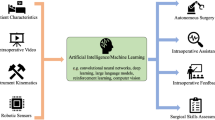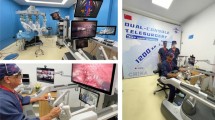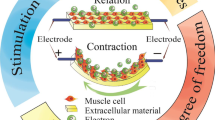Abstract
Purpose
Although robotic surgery has proved its advantages over traditional surgery methods, the lack of force sensing in the robotic systems poses a challenge to further advancements in the field. Many studies introducing force estimation to robotic surgery are tested on benchtop models. This is not an accurate representation of the robotic surgery environment. In this paper, the focus is on the development and validation of a surgical robotic tool capable of 3 degrees of freedom (DOF) force sensing while being employed in-situ in its native environment.
Methods
The da Vinci surgical system was paired with the da Vinci research kit (dVRK) to create a surgical robotic research platform. A da Vinci classic mega needle driver tool was instrumented with fiber braggs gratings (FBGS) strain sensors to estimate force measurements. The installation and cable management of the optical fibers allowed for native tool use. The tool was calibrated using a surrogate tissue rigidly attached to a 6 DOF industrial grade load cell. Validation was performed on three different models: (1) surrogate tissue, (2) bovine tongue, and (3) porcine uterine horn.
Results
The sensor instrumented tool estimated forces with a root mean error of under 1 N on all 3 models while performing complex teleoperation tasks.
Conclusion
The design described demonstrated the ability to accurately measure force on tissue surrogates in an in-vitro setting. By providing a robotic-MIS surgical tool capable of force sensing and that allows native use of the surgical robotic system, further research into clinical applications of force measurements can be achieved.








Similar content being viewed by others
Data availability
My manuscript has no associated data or data will not be deposited.
References
Aggarwal, R. (2004). Robotics and surgery: A long-term relationship. International Journal of Surgery, 2(2), 106–109.
Armijo, S. P. E. B. P. R. (2018). Growth in robotic-assisted procedures is from conversion of laparoscopic procedures and not from open surgeries’ conversion: A study of trends and costs. Surgical Endoscopy, 32, 2106–2113.
Olavarria, K. B. S. S. O. A. (2020). Robotic versus laparoscopic ventral hernia repair: Multicenter, blinded randomized controlled trial. bmj. https://doi.org/10.1136/bmj.m2457
Surgical, I. (2020). Da Vinci X/Xi instrument & accessory catalog. Intuitive Surgical Inc.
Reiley, C. E. (2008). Effects of visual force feedback on robot-assisted surgical task performance. The Journal of Thoracic and Cardiovascular Surgery, 135(1), 196–202.
Saracino, A. (2019). Haptic feedback in the da Vinci Research Kit (dVRK): A user study based on grasping, palpation, and incision tasks. The International Journal of Medical Robotics and Computer Assisted Surgery, 15(4), e1999.
Trejos, A. (2010). Force sensing and its application in minimally invasive surgery and therapy: A survey. Proceedings of the Institution of Mechanical Engineers, Part C: Journal of Mechanical Engineering Science, 224(7), 1435–1454.
Liang, Q. (2018). Multi-component FBG-based force sensing systems by comparison with other sensing technologies: A review. IEEE Sensors Journal, 18(18), 7345–7357.
Ricchiuti, D. (2010). Diminished suture strength after robotic needle driver manipulation. Journal of Endourology, 24(9), 1509–1513.
Kaushik, D. (2012). Effect of robotic manipulation on unidirectional barbed suture integrity: Evaluation of tensile strength and sliding force. Journal of Endourology, 26(6), 711–715.
Hadi Hosseinabadi, A. H., & Salcudean, S. E. (2022). Force sensing in robot-assisted keyhole endoscopy: A systematic survey. The International Journal of Robotics Research, 41(2), 136–162.
Amirabdollahian, F. (2018). Prevalence of haptic feedback in robot mediated surgery: A systematic review of literature. Journal of Robotic Surgery, 12, 11–25.
Kazanzides, P. (2014). In An open-source research kit for the da Vinci® Surgical System, IEEE international conference on robotics and automation (ICRA).
Shahzada, K. S. (2016). Sensorization of a surgical robotic instrument for force sensing. Optical Fibers and Sensors for Medical Diagnostics and Treatment Applications XVI, 9702, 153–162.
Wallace, S. M. B. J. (1997). Randomized trial of different insufflation pressures for laparoscopic cholecystectomy. British Journal of Surgery, 84(4), 455–458.
Kim, U. (2017). S-surge: Novel portable surgical robot with multiaxis force-sensing capability for minimally invasive surgery. IEEE/ASME Transactions on Mechatronics, 22(4), 1717–1727.
Kim, U. (2020). S-Surge: A Portable Surgical Robot Based on a Novel Mechanism With Force-Sensing Capability for Robotic Surgery. Handbook of Robotic and Image Guided Surgery (pp. 265–283). Elsevier.
Funding
This work was funded and supported by Ethicon inc.
Author information
Authors and Affiliations
Contributions
All authors contributed to the study conception and design. PB and SK: Hardware preparation and manipulation was done. MS, SC, and SK: Material preparation, data collection, and analysis were performed by a collective effort. MS: The first draft of the manuscript was written. All authors read and approved of the final manuscript.
Corresponding author
Ethics declarations
Conflict of interest
The authors have no relevant financial or non-financial interests to disclose.
Ethical Approval
This study did not require ethics approval.
Consent to Participate
No human subjects were involved in this study.
Consent to Publish
No human subjects were involved in this study.
Additional information
Publisher’s Note
Springer Nature remains neutral with regard to jurisdictional claims in published maps and institutional affiliations.
Rights and permissions
Springer Nature or its licensor (e.g. a society or other partner) holds exclusive rights to this article under a publishing agreement with the author(s) or other rightsholder(s); author self-archiving of the accepted manuscript version of this article is solely governed by the terms of such publishing agreement and applicable law.
About this article
Cite this article
Soudan, M., King, S.L., Chung, S. et al. Development and Validation of a 3DOF Force Sensing Tool for In-Situ Surgical Robotics. J. Med. Biol. Eng. 43, 332–338 (2023). https://doi.org/10.1007/s40846-023-00800-4
Received:
Accepted:
Published:
Issue Date:
DOI: https://doi.org/10.1007/s40846-023-00800-4




